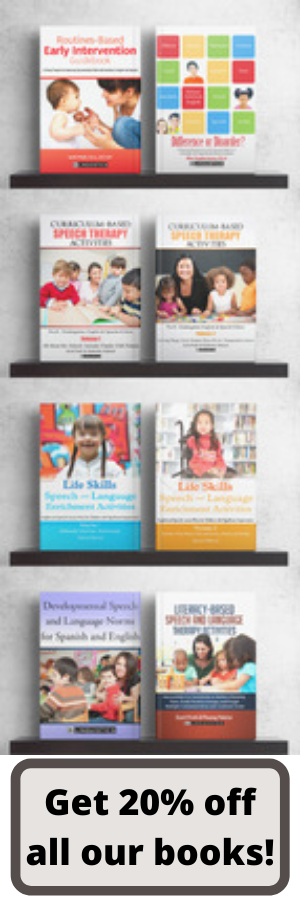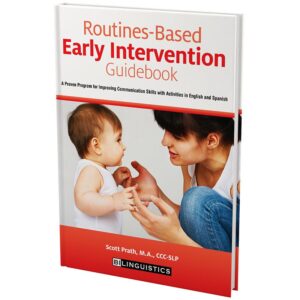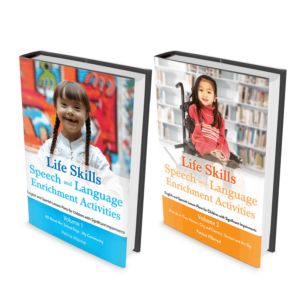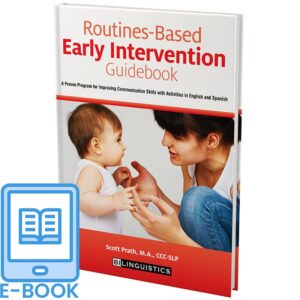Life Skills Speech and Language Enrichment Activities: Volumes 1 & 2
$40.00

Boost your Confidence and Navigate the Challenges of the Life Skills Classroom.
For those of us who have had the opportunity to work in a life skills classroom we know that it can be the most rewarding and most challenging experience. However, serving children with severe impairments is almost always heavily weighted towards the challenging end of the spectrum. But does it have to be?
What makes life skills intervention so difficult?
It is the fact that we can rarely produce therapy materials that can be used again and again because each activity has to be individually modified for each individual student. The degree of support needs across clients differs so radically due to augmentative communication needs, hearing and vision loss, and reduced mobility.
These books will change the way you do therapy! Take a look:
Let’s change the way we do therapy.
These 2 books have over 450 pages of powerful therapy materials that can be re-employed each year by maintaining the curriculum-based theme and adapting the modifications and augmentative communication support.
We need to collectively make a pact to compile quality resources and improve upon our intervention so that our field can move forward. That is what this book is designed to do.
Additional Information
| Weight | 2.75 lbs |
|---|---|
| Dimensions | 11 × 8.5 × 1.12 in |
In our work as speech-language pathologists, we have found great challenges in working with the students in life skills classrooms. These classrooms, also referred to as Functional Life Skills, Functional Communication Classes, Structured Learning Centers, and Low-Incidence Classrooms, are generally self-contained classes in which students are segregated from the general education population for a portion or all of their day in order to receive the support that they need to be successful in their community.
Students in elementary life skills classrooms are generally between the ages of 6 and 12 years of age and they have one or more of the following disabilities:
orthopedic impairment (OI)
other health impairment (OHI)
intellectual disability (ID)
emotional disturbance (ED)
learning disability (LD)
speech impairment (SI)
autism (AU)
traumatic brain injury (TBI)
auditory impairment (AI)
visual impairment (VI)
Although these children have a severe level of impairment, it is our responsibility as professionals to expose them to age-appropriate material and content regardless of their level of functioning (ASHA, 2010). The seeming disconnect between the rigor of the academic curriculum and the overall communication levels of these children can be overwhelming. Language skills are the foundation of learning and it is our job to bridge the gap between a student’s current language skills and the way academic material is presented so that students are able to learn new concepts and participate to their fullest potential in the academic setting.
The need to bridge the gap between communication skills and academic material for children with profound disabilities drove our goal to create effective intervention units that can address the unique needs of several students in the same session. We needed intervention plans that not only contained content consistent with the school-based curriculum, but that could be easily modified, both physically and linguistically. This was the catapult for the development of our communication units for children with profound disabilities.
We have created this book to share our experiences with you. We constructed and field tested a series of curriculum-based sessions that introduce age-appropriate concepts and modifications for a wide range of disabilities. Our nine theme-based units (thee units in each volume) make it easy for speech language pathologists and teachers to incorporate the requirements outlined in the Texas Essential Knowledge and Skills and the Common Core Standards curriculum with appropriate modifications for all students. These units were created, tested, changed, edited, added to, and honed by our team of 20+ speech-language pathologists. Now we want to share them with you.
Enjoy and watch your students’ communication skills grow!
UNIT COMPONENTS
Each unit begins with an information page that highlights specific language targets, the curriculum addressed, and provides a list of songs and materials needed to carryout the activities. The information page is a resource that can be shared with the classroom teacher to enhance collaboration. A modifications page is also included at the beginning of each unit. The modifications page allows the SLP and teacher to plan for diverse student needs within each lesson. Each unit also includes picture cards that can be used during the surprise bag activity, a sentence strip, visuals for a related song, games, a craft activity, and a recipe.
Each lesson plan highlights the suggested sound targets, a question of the day, a story, a story board, and comprehension questions. Below you will see a typical lesson plan structure incorporating all of the components mentioned previously.
The first three activities are suggested to be done in a group. This is ideal when teachers and/or teacher aids are able to participate. For the following activities, it is optional to split the class into individual therapy sessions and/or small groups depending on students’ needs. The lesson plan at the beginning of each unit provides an estimated time frame for each activity so you can select an activity or set of activities that will work within your time frame.
7 reviews for Life Skills Speech and Language Enrichment Activities: Volumes 1 & 2
Need CEUs?












Ofelia Hoover –
An awesome product. Have been able to use in our PPCD classroom, our elementary and secondary supported education classrooms, and some in our ESL classroom. Great use for introducing concepts all in one place.
Amber Rokas –
This book has changed the way I approach group therapy in the life skills classroom. The lessons are so easy to use and adapt. I love to see the anticipation now when I pull out the surprise bag
Kara –
I agree with Amber, this book has changed my approach to serving my self-contained kids. When will Volume II be finished?!?!?!?
carly –
This is a wonderful resource! I so appreciate the way it can be modified for different levels with regards to cognition and communication. Is there anyway to get the color version of the book? Thank you for your efforts in putting this together and sharing it! Amazing!
Scott Prath –
Glad you loved it. We are also having amazing results in our LS classrooms and by modifying the activities we have been able to not reinvent the wheel for every student. We are working on a way to provide color copies. The book is so large that a color version is cost prohibitive. We are making digital color sections available on the Speech Therapy Materials page. Click on: Lifeskills Eng Spn Story Communication Boards.
Andrea –
Pros:
-Well laid out, with each section organized to make planning for verbal and some nonverbal students straightforward
-Very functional, with sections on health, occupations, and location
-Lots of ready to go materials, provided you have time to photocopy, cut, etc.
Cons:
-not in color (bummer for students with vision impairment)
-not digital, so pictures cannot be blown up easily (see above)
-Not very much information/planning resources for more severe students (e.g., a student with vision impairment, athetoid cerebral palsy, no vocalizations, and always tipped back in a chair 30 degrees). There is some info on lesson plans for students with pre/emergent communication including a schema for determining joint attention skills, but not much. It’s not systematic. While the book acknowledges these students are there, there is not an intensive plan for doing interventions with them, e.g., integrating big macks, 4-square communicators, switches. Maybe that’s just too big a task for one book. If Bilinguistics writes a book for students with these very severe limitations (sort of an updated version of ‘Every Move Counts’?) I will buy it.
Scott Prath –
Thank you for your comments. So much need for materials to serve the lifeskills classroom and really difficult to get it all into one book! What we were able to accomplish with these books was to provide reusable content for 9 curriculum topics that was affordable, in Spanish and English, and the ability to modify content based on different limitations. We are proud of what we accomplished but your suggestions for ideas to incorporate is well stated.
Customers like you have requested a color version of the book but it is 250 pages and a color version would almost double the price which is outside of most school budgets. We are considering a digital version at this point. For more information on pre/emergent communication check out our book Routines-based Early Intervention Guidebook.
Brenda Oksanen –
I have both volumes in this series of books. As a busy Speech Language Pathologist working in the schools, this has been my “go to” resource for my life skills lessons. I used to spend so much time prepping for those therapy sessions, and now my materials are ready to go. There are several brilliant pieces to this resource. The structured visual schedule really keeps my students focused and aware of what we are doing that day. I love the question of the day and it’s always fun to see the kids participate and be able to answer no matter regardless of their level of communication. The surprise bag never disappoints and the kids LOVE seeing what pictures are in there each time. It’s great that there is a mixture of activities (songs, recipes, crafts, and games) to go with each unit. In the past it has been a struggle for me to find books that were mature enough but simple enough for my students. The stories provided in this book are exactly that. The visual picture cues have been invaluable in supporting language from my students. I especially appreciate the story questions presented with visual picture answers saving me so much preparation time. I also use many of these materials with my students with autism. I find that it works great with them as well. Again, the visual supports are simple, time saving, and invaluable. Excellent resource
Ellen Kester –
Hi Brenda, Thanks for your kind comments about the Life Skills books. I agree that they save tons of time. Patricia Villarreal Ybarra did an amazing job on these books! Thanks for helping us spread the word about how great they are!
Kristina Carnes –
This book has relevant information and great lessons for students in a life skills classroom. I like that the communication boards are already prepared and only need to be copied. The only thing I wish was different would be to separate the Spanish and English versions. I have students with Autism who got very distracted by the Spanish print on the page. A CD of the printables would also be awesome! Overall, this is a great tool to have in your bag.